Tabbed Boxes with Living Hinges
.PY File Direct Link .INX Direct Link
GPLv3 License File
Scroll down for installation instructions and details.

The living hinge box was used to hold my engagement ring for my proposal. It's a fork of the awesome Tabbed Box Maker by Elliot White under GPLv3. Inkscape is used to render the final SVG files, giving a robust cross-platform generator application.
These boxes are designed to be cut with a laser cutter, as they require tight tolerances instead of glue or nails to hold together and complex cuts to form living hinges. Selective weakening of the box material allows solid material to flex and bend. The ideal material for this is plywood or other composite product, although I have working examples in hardwood board (like the cocobolo demonstrated above), acrylic, and cardstock. In theory it may be adaptable to CNC milling, but I haven't tried.
The above pictures also demonstrate a novel living hinge design I do not believe has been previously used, called the "Double Spiral". Although it's less durable and binds easily, it is extremely decorative and lasts long enough for small sentimental objects, such as the ring box pictured above. It also supports more traditional durable lattice based designs and the extremely flexible "parallel snake" type design.
Inkscape provided install instructions.
Installing is as simple as copying the script (unless it resides in your path) and its INX file to the inkscape/share/extensions ($HOME/.config/inkscape/extensions) directory.
If you installed on Windows, this is most likely "C:\Program Files\Inkscape\share\extensions" or "C:\Program Files (x86)\Inkscape\share\extensions".
After install, start Inkscape with a blank document. The tool is available under the Extensions->LaserTools->Living Hinge menu item.
- Hinge type is described below.
- Unit is millimeters, centimeters, or inches. Units must be identical for all values, but need not match document units.
- Box dimensions can either specify external or internal (IE: overall length is material thickness * 2 + interior) dimensions.
- Length/Width/Height are self explanatory.
- Minimum/Preferred Tab Width is used to calculate the width of the tabs overall. If fixed, this is the length (plus/minus small variations for kerf and corrections). If proportional, this is the average target size.
- Fixed size tabs have the same tab sizes throughout the part, except where shorter because the edge of the box ends. Proportional tries to keep all tabs on a single side the same width.
- Material thickness is used to determine the depth of tabs.
- Kerf is how much material your laser ablates away. Cut a box of a known specific size and then measure its error to determine this. Higher kerf numbers here make tabs tighter together, not looser since it's a positive correction factor.
- Specified clearance between tab & hole parts. This is the main variable you should tweak to get solid fits without breaking material. Higher numbers give looser tabs.
- Diagrammatic layout has the sides laid out in a diamond according to their position, with the hinged lid to the far right. In-line creates a single line of parts, useful for long but narrow hardwood board.
- Space between parts is how much wasted material is left in between cuts (material that otherwise is unusable).
- Hinge remaining wood thickness is how much wood to leave inside solid portions of the various living hinge designs. More material (higher numbers) generally leads to less fracturing, less bendable parts. Thin numbers give greater flexibility but can reduce durability once the material can't support the forces. Play around with this, a happy medium is almost always best.
- Lid thumb tab length specifies how long the extra tab past the end of the hinge should be. 0 will remove the solid tab altogether, but the box gets hard to open.
Standard Parallel Slit
The standard "parallel slit" living hinges is the best all-around performer. It lacks the flexibility of the parallel snake design, but gains both durability and resilience against stretching.
Single Spiral
This design is largely impractical, and simply left in for completeness.
Double Spiral
The double spiral design is the decorative hinge demonstrated above. It doesn't have quite as much flex ability as other designs, but is very decorative. This design has a tendency to bind unless you push the lid away from the main body slightly.
Parallel Snake
This design has the largest flexibility of all the designs, you can get a 180 degree bend in wood with only a a few hundred square millimeters.
Perpendicular Snake
This design is largely impractical, and simply left in for completeness.
Double Perpendicular Snake
This design requires particularly large dimensions (preferably in width, but height can work too) to be practical. It has a lot less flexibility, but provides strong spring force. It also provides extremely good rotational flexibility & durability, if needed outside of a box concept.


